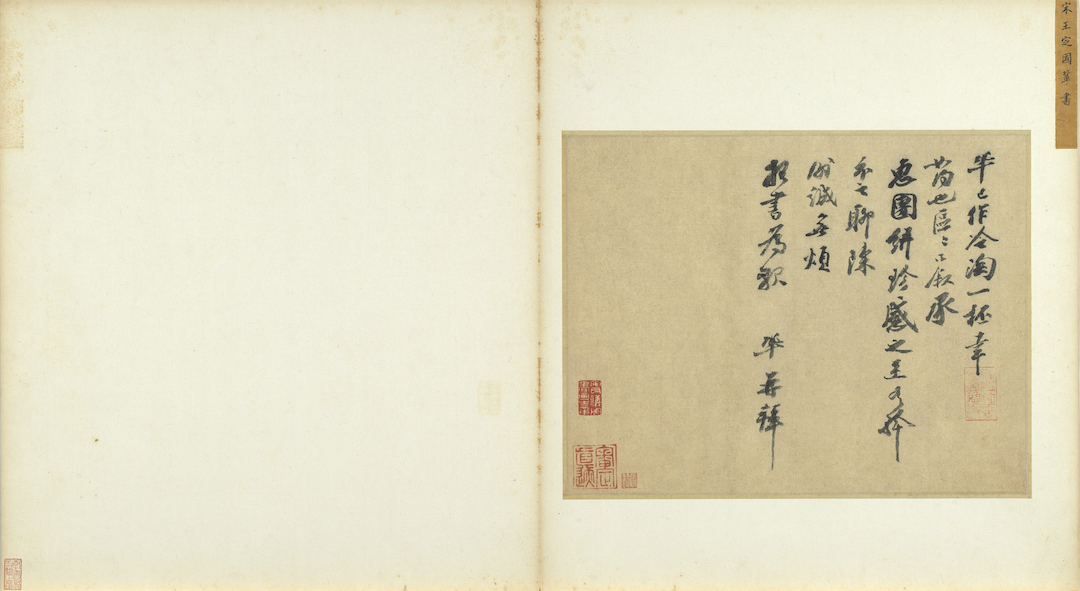
Chen Hongshou in the Ming Dynasty was a painter of figures and flowers and birds, and he played an important role in the history of Chinese painting art.
2022 is the 370th anniversary of Chen Hongshou's death. Recently, "Gao Gu Qi Hao - Chen Hongshou's Painting and Calligraphy Exhibition" is on display at Xuwei Art Museum (Shaoxing Museum Branch). , "Xuanhua Zhishi map" axis and so on. The exhibition focuses on Chen Hongshou's figure paintings, selects his works of different periods and different themes, as well as his cultural background and the inheritance of his teachers and friends, showing the artistic spirit of tracing the origin, uniqueness, and individuality behind his painting style.
For more than 300 years, Chen Hongshou's paintings have been radiating strange brilliance in the Chinese painting circle, especially his paintings have laid the foundation of the largest painting school in the modern Chinese painting circle, the Shanghai School. The influence of the Shanghai faction has spread all over the country, and even as far away as the United States, Japan, Britain, Canada, France and other countries and Southeast Asia.
1. The Art of Chen Hongshou
According to the summary of the Qing Dynasty, Lao Lian's paintings have four changes in brush and ink throughout his life, and enter the "three realms", that is, from "miao" to "spirit," from "spirit" to "hua". In Chen Hongshou's "Fan with Flowers and Birds" in the Palace Museum, Tang Jiujing said: "(Chen) Zhang Housheng was not yet sixty years old, and his brushwork and ink changed in four ways. The change is also rapid in ten years, so it is from the young to the strong, and it is the time when the wonderful person is born. Zhang Lao (Hong Shou) tasted the day of self-assessment: 'Yu painting to the old is not the way of writing and ink, but I want to do it instead. If it is done by Zhuang, it cannot be done. 'Looking at this, I know that its evaluation is not wrong. " This comment is generally fair. (The ancients said "less" generally refers to under the age of 30.) The so-called "hua" means the extreme, and Chinese painting ranks "nature" as the top grade, which is later called "ease". .Chen Hongshou's "transformation" not only includes "Yi", but also fully reflects Chen Hongshou's character in his paintings. "Zhuangzi" is called "materialization", it is "Tao" and not only painting. Chen Hongshou's old paintings" "Transformed", that is to say, it has completely broken away from the mundane realm and entered the most transcendental realm. The works of Chen Hongshou in his youth that I have seen are earlier than the "Chen Hongshou Father and Son Collection" collected by Weng Wange. Judging from the style , When painting before the age of 30, Meizhi's brush was rigid and hard, firm and solid, which was the painting method of the Southern Song Dynasty. The painting method of the Northern Song Dynasty was hard but not rigid. Hong Shou lived in Hangzhou in his early years, and Hangzhou was the political culture of the Southern Song Dynasty. Therefore, there are many paintings in the Southern Song Dynasty. The figure paintings he created around the age of 30 also like to use this kind of rigid straight lines.
In his early years, Chen Hongshou's flower and bird paintings were mainly based on the masters of the Song Dynasty. They were solid and rigorous, rich and vigorous. Although there are some personal features, they are not prominent, so they can only be listed as wonderful or capable. Chen Hongshou's paintings of flowers and birds in his prime are much more than those in his early years. "Ming-Chen Old Lotus Birds, Grasses and Insects" contains ten pieces, a set of albums he painted when he was 37 years old. This set of paintings is the work of Chen Hongshou when he was just entering his prime, and it is also a work from the time when Miao became fascinated.

Ming Chen Hongshou, Lotus and Mandarin Ducks Scroll Collection of the Palace Museum
The scroll of "Lotus and Mandarin Ducks" in the Palace Museum is a representative work of Chen Hongshou in his prime. In the painting, the lotus flower is covered with white powder, and the tip of the flower is light red, which is thick and not flashy; the lotus leaf is dark green with prominent veins. The most rare thing is that the colors of the brush and ink are very quiet and composed, which shows that Chen Hongshou's personal style has matured. It's just that the big rock in front of the lotus is still outlined by a solid line with a hard and square fold (the line is thicker and wider than the line used in old age), and it has not yet been "melted". Butterflies and mandarin ducks in the water are much more "chemical" than those in the early years. Therefore, this type of painting can be described as the main appearance of the "God" in the prime of life.
In Chen Hongshou's early and strong years, the lines used for painting stones were relatively thick and hard, thick and solid, and straight and square hooks. In the paintings made in his later years, although the stone shapes are the same as those in the middle-aged period, the lines used have become thin and soft, smooth and gentle, round and delicate, without the rough and straight-forward atmosphere of the early years. In addition, it becomes soft and firm on the whole, and strong on the outside is introverted (energy is concentrated), there is no moss, and there is no strong and stimulating moss like in the paintings of the early and middle-aged, and the coloring becomes more pale. Beyond the Song and Tang Dynasties, it went straight to the abyss of the people of the Six Dynasties. Paintings in the later years are only laid with light powder, unlike the works in the early years and the prime of life, which are covered with heavy powder. The lines of the branches and flowers are not as serious as in the early years, with heavy and solid brushwork, but written casually, soothingly and even vaguely. The lines seem to be irregular on the surface, but in fact the inner changes are wonderful, revealing the author's emotion and interest everywhere. Butterfly is also much more elegant than the earlier paintings, the color contrast is not strong, but there are very subtle changes. The green flowers and leaves are not as rich and heavy as the green leaves painted in the early years, but they do not appear thin, but have a more natural feeling.
To sum up the paintings of Chen Hongshou in his later years, it can be said that the works are simple and elegant. In his early years and in his prime, he sought details in his paintings; in his later years, he inadvertently revealed brief sketches of brush strokes, ink sketches, color sketches, and objects and scenes, which are called trace sketches. In the early years and in the prime of life, he used kung fu painting, seeking strong contrast, and using heavy brush and ink. The early and middle-aged paintings are created with heart, and the brush, ink and color are very particular, and they are not natural, so they are not "light" to a certain extent; Tranquility, emptiness, and a soothing atmosphere are called Yazheng. A person who is in a state of irritability must have irritable ink in his writing. In particular, such ancient lines in Chen Hongshou's paintings cannot be drawn by those who are upset. A person who is snobby and wants to appeal to others with his paintings, his brush and ink must follow the vulgarity, and he must be comprehensive. Because the purpose of painting is not correct, the painting is also vulgar, not only cannot be elegant and correct, but also must go to its opposite: vulgar and not correct.
Chen Hongshou's paintings in his later years surpassed the "god" and entered the realm of "chemical". The paintings of this period are so peaceful, natural, simple and without lack of subtle changes, a "transition" environment. Not only did the people of the Ming and Qing dynasties fail to achieve this level, it was also rare in the works of the great painters of the Song and Yuan Dynasties. As mentioned earlier, it has surpassed the Song and Tang Dynasties, and has entered into the aristocracy of the people of the Six Dynasties, but it is much more mature and richer than the people of the Six Dynasties.
What Chen Hongshou is best at and has achieved the most is figure painting. It should be said that his landscapes are all influenced by his figure painting.
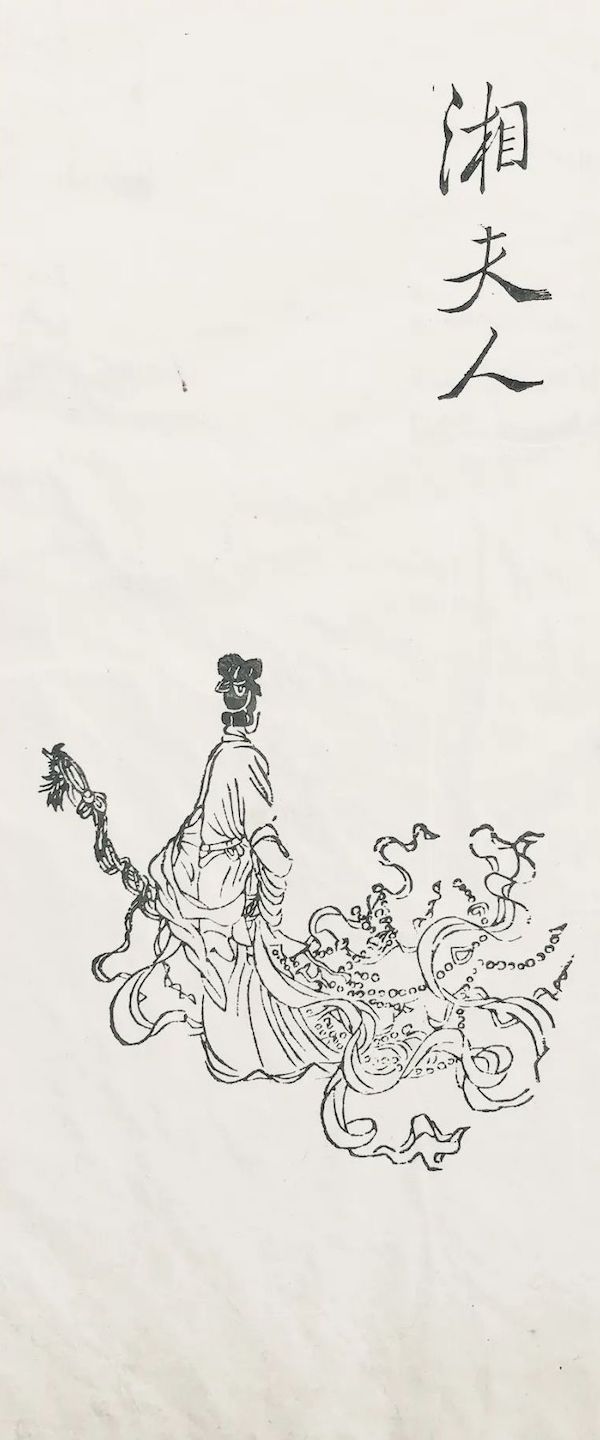
Chen Hongshou, Ming Dynasty, Mrs. Xiang of the Nine Songs, and Kangxi's block-printed edition of "Chu Ci Commentary" Collection of the Library of Luxun Academy of Fine Arts
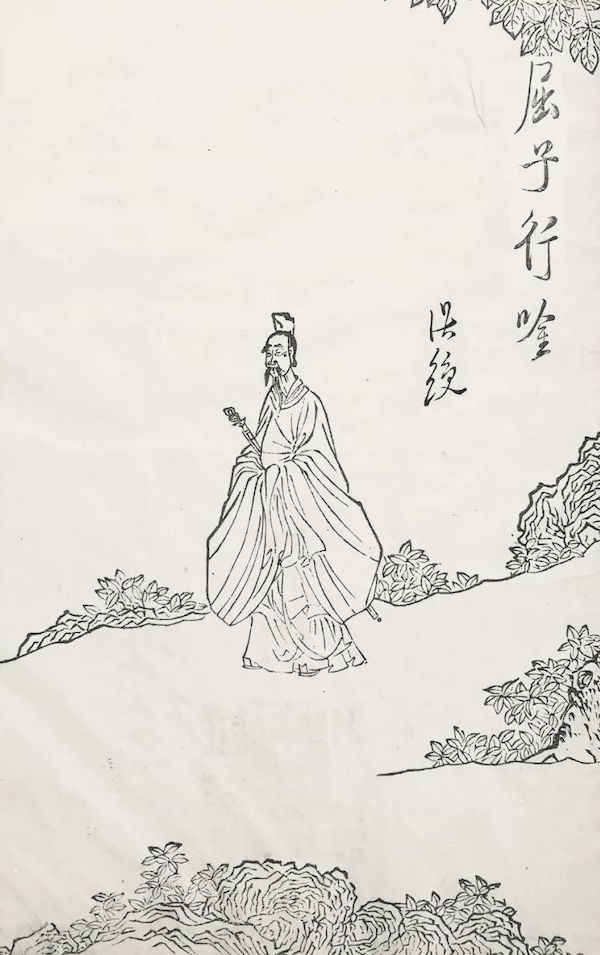
Ming Chen Hongshou, Qu Zixing Yin Figure, Qing Kangxi block edition "Chu Ci Shu Zhu" Collection of Luxun Academy of Fine Arts Library
Eleven of the extant "Nine Songs" plus a portrait of Qu Yuan (generally called "Qu Zi Xing Yin Tu") are works by Chen Hongshou when he was young, and it can be confirmed that he did it when he was 19 years old.
One; according to Chen Hongshou's friend Zhou Lianggong:
Zhang Hou studied painting when he was a child, and his shape was irregular. He crossed the river and expanded Hangzhou to study Longmian's "Seventy-two Sages Stone Carvings". He closed his home and copied it for ten days. It seems." (Chen) was happy. It was copied for ten days, and he also showed people, "What is it?" He said, "Don't look like it." He was even more happy. Copy as many as possible and change its method, easy to round to square, easy to rectify and scattered, people can't distinguish it.
Hangzhou Fuxue was a royal school (Taixue) in the Southern Song Dynasty. It was originally the residence of Yue Fei, and Long Mian was Li Gonglin, a great painter in the Northern Song Dynasty. Emperor Gaozong of the Southern Song Dynasty visited Taixue and ordered the images of Confucius and his seventy-two disciples to be engraved in Taixue and added praises on it, so he engraved the "Sages and Sages" created by Li Gonglin of the Northern Song Dynasty. This set of pictures is still in the Confucius Temple in Hangzhou. Confucius is sitting on the couch, and seventy-two sages are standing listening to the teaching. There are seventy-three people in total, and they are carved on fifteen rectangular stones. Except for the tenth stone, which has been lost, the rest are intact. Li Gonglin's painting studies Gu Kaizhi, Lu Tanwei, Gu and Lu were painters of the Six Dynasties. The thread used is as thin as a gossamer, which is called "spring silkworm spinning". The extant Li Gonglin stone inscription "Sages and Sages" is like this. Chen Hongshou crossed the river and went to Hangzhou Fuxue Zhongxue to expand the painting, and then closed his door to copy it for ten days. When others saw it, he was very happy. He copied it for another ten days. Because he copied it several times, he changed his method, from round fold to square fold, from whole to scattered, and changed it into his own method. Judging from the existing brushes in Chen Hongshou's "Nine Songs", most of them are thin and round, but there are also many square folds. In his middle-aged painting "Water Margin Leaves", the straight folded square brush has become its distinctive feature. The lines drawn by the people of the Six Dynasties are long and drawn from top to bottom, so they are called whole. Chen Hongshou's lines became square, with turning points, beginnings and endings, hence the name "scattered". However, in his later years, Chen returned to the fine circle of the six dynasties Gu and Lu used the pen like a hairspring (details below). At first, he came to see the similar, because he had mastered the techniques of the ancients, so he was happy; later, he came to the different, because he had a new technique of his own, so he was even more happy.

Ming Chen Hongshou Water Margin Leaf
Second, Chen Hongshou's "Self-indulgence of Zhou Chang's History Paintings" says:
I copied Zhou Changshi's paintings, but I couldn't stop it again and again. People said, "This matter has already passed Zhou (surpassed Zhou Changshi), but it is still a mouthful (regret), why?" I said, "This is why it is not enough. This is also the case. My paintings are easy to see and good, but what can be done is not complete. Long history is very capable, but if it is incompetent, it is impossible.”…
From this passage, it can be seen that Chen Hongshou copied the paintings of Zhou Changshi. Zhou Changshi is Zhou Fang, a famous figure painter in the Tang Dynasty. Zhou Fang drew figures from Zhang Xuan, and then surpassed Zhang Xuan. He created "Water Moon Avalokitesvara", a painting of the Buddhist Avalokitesvara Bodhisattva looking at the moon by the water, which is very novel, and is known as the "Zhou Family Style" from many scholars. Zhou Zuo's paintings "simple and simple clothes, soft and beautiful colors", "Fang painted women, mostly those with rich attitudes". Zhou Fang's "Picture of Ladies with Hairpins and Flowers" is now in the Liaoning Provincial Museum. The lines are clear, round and fine, sparse and soft. The women in the painting are all fat, which is indeed similar to Chen Hongshou's painting.
In fact, Chen Hongshou's paintings were most influenced by Zhou Fang's style. In the Ming and Qing dynasties, the figures and ladies' paintings are all thin and slender, but the figures in Chen Hongshou's paintings are relatively fat, some are very fat, and there are very few who are not fat. At that time, some people ridiculed him that the woman he painted was too fat, but Chen Hongshou did not accept this opinion. According to Zhou Lianggong:
Jun Zaiyun: Zhang Xuan is not on the right side of Zhou Fang. He has seen ten copies in his life, and he has collaborated with them all (high-quality products). The painting of women is based on Zhu’s dizzy ears. The rest is rich and sandy, and Zhang Shi only entrusts the monarch to benefit the rest with a roll of a lady from Xuan. She is beautiful and plump. Not only is the red ear dizzy, but also has a big swallow (rouge) on her cheeks. Although the silk is broken (broken), she looks bright also. To show the Marquis of Chen Zhang, he said: Don't do anything other than Xuan. He was amazed and said, "You often accuse Yu's daughter of being too fat, so when I try to read this volume, there are too many lingers between my fingers.
When Chen Hongshou saw that the ladies painted by Zhang Xuan were very fat, he said, "Look at Zhang Xuan's paintings, the ladies under me are much slimmer.
The original Central Academy of Arts and Crafts has Chen Hongshou's "Ladies in the Mirror" (silk edition), and he knows it: "Hongshou is like (gifted to) Brother Tian'er Society." In the painting, a beautiful young woman admires herself in the mirror. The lines of the clothing lines in the paintings are thin and vigorous, but they are different from the fine, uniform, round, soft rhythms of the lines in his later works. The lines in the prime are basically thin and even, but there are still twists and changes in severity, and they contain the benefits of vigor and vigor, which are not as ancient as the lines in the later years.
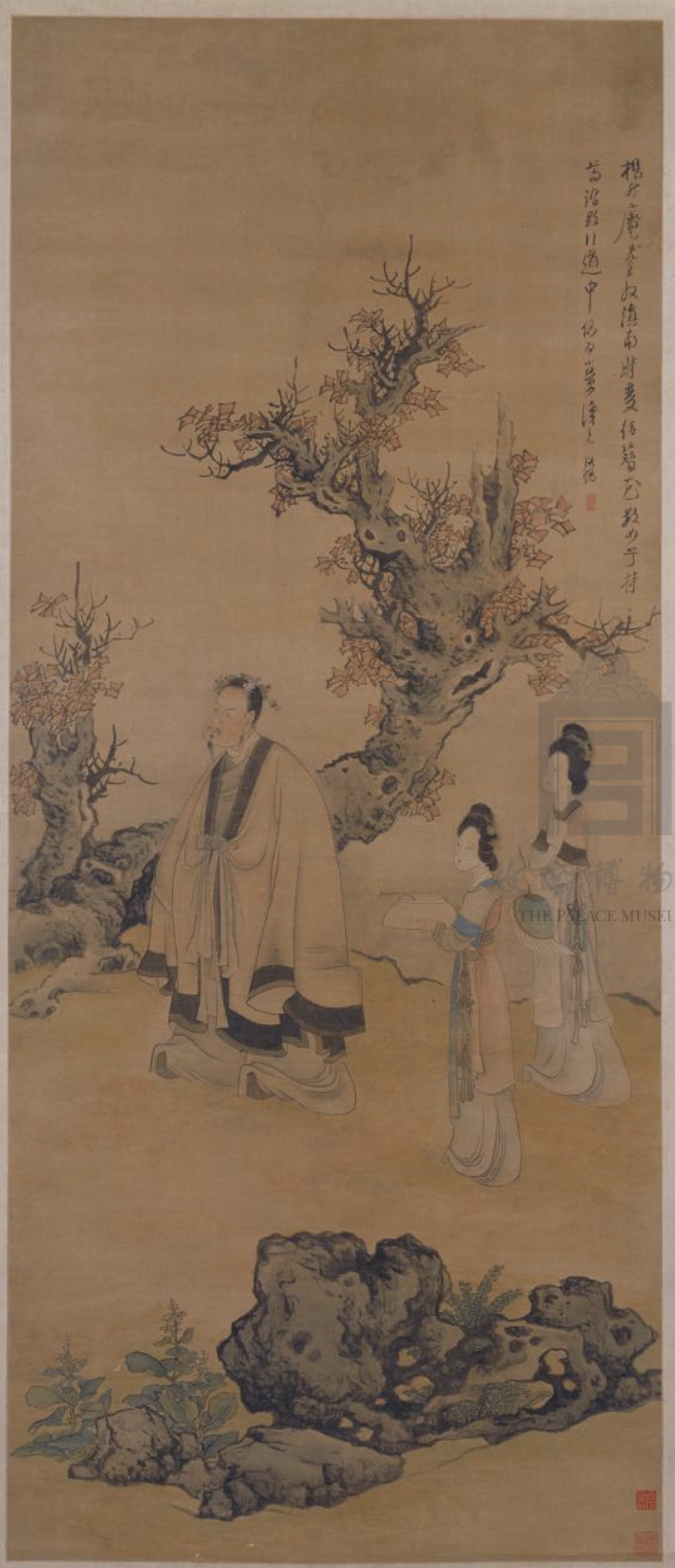
Ming Chen Hongshou, Yang Sheng'an's Hairpin and Flower Figure Collection of the Palace Museum
Chen Hongshou's "Yang Sheng'an Hairpin with Flowers" (on silk) in the Palace Museum's collection is obviously his masterpiece. Judging from the style, it belongs to the same category as "The Lady in the Mirror", but it goes further and should be a work of his middle-aged age. The main character in the painting, a young man with flowers on his head, is Yang Shen (1488~1559). The lines of the characters in this picture are quite skillful. The painter always controls the brush in his hand, runs it gently, pays attention to his concentration, and exerts his energy everywhere. It is not like the lines in "The Lady in the Mirror", which are different in weight, hardness and softness, but are like spring silkworms. It is as fine and even as silk, and a painter who lacks skill cannot control the brush to make it even, static, round and vigorous. Although the lines in this painting have not yet reached the level of quaintness and lightness of the lines in his later years, they are also very rare.
A further masterpiece than "Yang Sheng'an Flower Hairpin" is "Xuanwen Jun Giving Sutras" (on silk). This picture was made by Chen Hongshou for his aunt's birthday when he was 41 years old. In the picture, there is a lady (Xuan Wenjun) sitting in the high hall, the nine disciples at the bottom of the stairs are kneeling to the left and right, and the nine maids at the bottom of the hall are approaching both sides. The top and the front of the hall are surrounded by white clouds. There are large case barriers in the hall. In front of the steps, there are giant pine trees, flowers and water stones. The layout is exquisite, the scene is grand, and the momentum is extraordinary. This is one of Chen Hongshou's most powerful masterpieces in his life. Its characters have wide robes and large sleeves, and their shapes are all exaggerated. The white clouds are like the circle pattern of winding thread, which is solemn and full of decorative flavor. Except for the thin and square lines of the stone, the rest are like spring silkworms spinning silk. In his early years, Chen Hongshou learned painting from the Tang, Song and Six Dynasties. It was easy to form into scattered, and from a circle into a square. Now it has changed from a square to a circle, and from a scattered to a whole. Although the lines of the wide robe and the sleeves are long, they are all rooted to the end, without starting a new pen, without setbacks, without pauses, and the connotation of energy, concentration, and no slack, which is the most commendable. Since the Wei and Jin Dynasties, no one can surpass it. It can be said that "Xuanwen Jun Giving Sutras" basically established his painting style in his later years.
Chen Hongshou only lived to be 55 years old. The change of Jiashen (1644 when the Ming Dynasty fell) was a major turning point in his life. He was 47 years old this year. After Jiashen, Chen Hongshou wrote "Lao Chi Hongshou" or the books "Lao Chi" and "Repent of Chi" in most of his works.
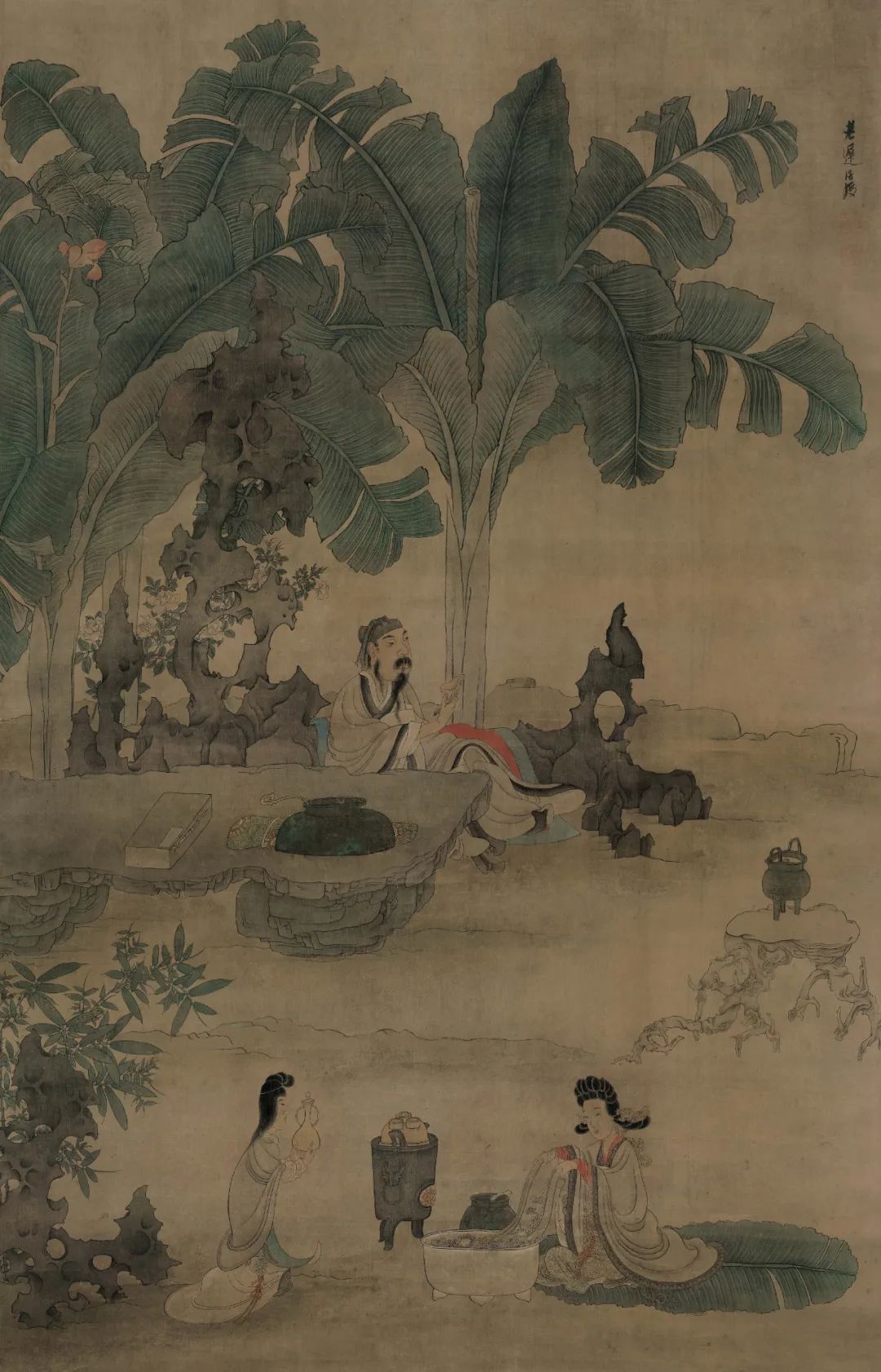
Picture of drinking wine in banana forest in Ming Dynasty, Ming Chen Hongshou, coloring on silk, collection of Tianjin Art Museum

Picture of drinking wine in banana forest
Chen Hongshou's works in his later years were not only refined but also numerous. The Picture of Drinking Wine in Banana Forest in Tianjin Art Museum is one of his representative works. In the painting, Gao Shi is drinking from a cup under the banana forest. In front of the stone table, two women are picking chrysanthemums to cook wine. On the right is a coffee table in the shape of tree roots. This painting is a self-portrait of Chen Hongshou's depressed mood in his later years, and there are many similar works. The upper right of the painting is from the book "Lao Chi Hongshou", with two seals, one is "Chen Hongshou" and the other is "Zhanghou". Chen Hongshou's figure paintings in his later years are consistent with his flower and bird paintings and landscape paintings. The line drawing of the characters is also basically the same as that in "Xuanwen Jun Giving the Scriptures", as thin as a gossamer thread. If you observe it carefully, although it is also like a spring silkworm spinning silk, it will become more delicate and ancient in old age, and its inner meaning will be richer. The lines of the figures he made in his middle age were thin and even but rigid, lacking the flexibility of his later years, and the lines of the clothing lines in his works in the early middle age were sometimes straight and folded, but in his later years they were all rounded. There are still hard pens on stones in the "Picture of Lord Xuanwen's Teaching of Sutras", but in his later years this kind of hard pens was completely eliminated. The stones in "Drinking Wine in Banana Forest" are the same as those in "Pillars of Jade Hall" in the Palace Museum. They are drawn with clear, round and thin lines. Although there are twists, they are neither hard nor frustrating, very soft. After the stone is hooked, it is no longer scratched, let alone moss, only a light color, very light, but never thin.
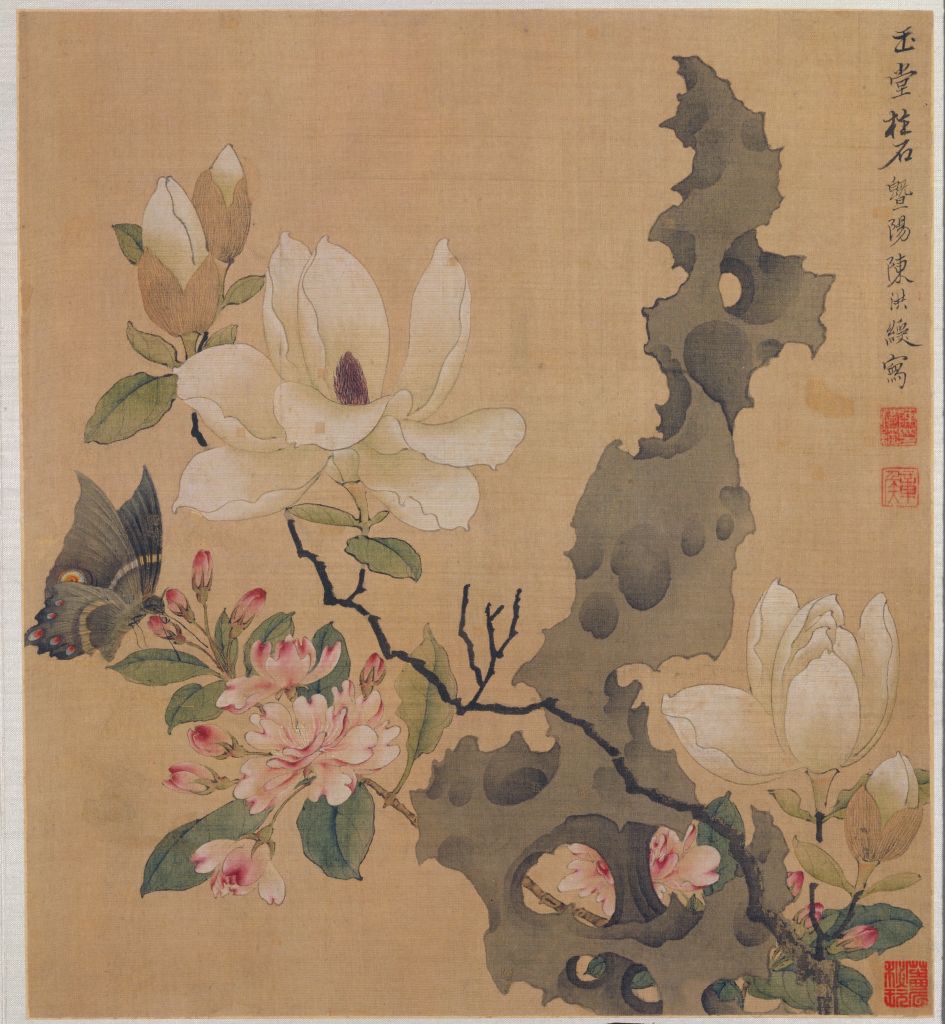
Ming Chen Hongshou's Miscellaneous Paintings, Jade Hall Pillars and Stones Collection of the Palace Museum
"Drinking Wine in Banana Forest" has a high and ancient style, and there are changes in the plain, which are more than before. His later works are generally similar. In the picture, the woman pouring chrysanthemums into the vat is sitting on a plantain leaf, which is quite interesting. In another of his works, "He Tianzhang Xingle", a woman is also sitting on a plantain leaf, and the painting method is also the same.
Chen Hongshou's "Cage Goose" in the Zhejiang Provincial Museum, depicts the story of Wang Xizhi's love for geese, a great calligrapher in the Eastern Jin Dynasty. There is no background at all, and the self-titled "Fengxi Lao Chi Hongshou painted in Shenliutang" on the upper right. It can be seen that this is the work of Chen in his later years. The clothing patterns of the figures in this picture are as old as those in other works of Chen's later years, they are clear, round and delicate, and because the figures are standing statues, the long sleeves are hanging down, and the lines are special, which makes them look particularly smooth, and the characters' characters are also portrayed quite well. success. During the Eastern Jin Dynasty, Wang Xizhi and other literati had a soothing temperament and soothing belts. The painting depicts Wang Xizhi's temperament and the characteristics of soothing belts and movements. Moreover, Wang Xizhi's elegant and refined literati charm is obviously different from that of the servant behind him. Chen Hongshou's figure paintings are generally pale in color, but in this picture, the robes are red and purple, and the circles are blue, all of which are dark and rare. The plumpness of the characters is one of the characteristics of Chen Hongshou's modeling, which is worth noting.
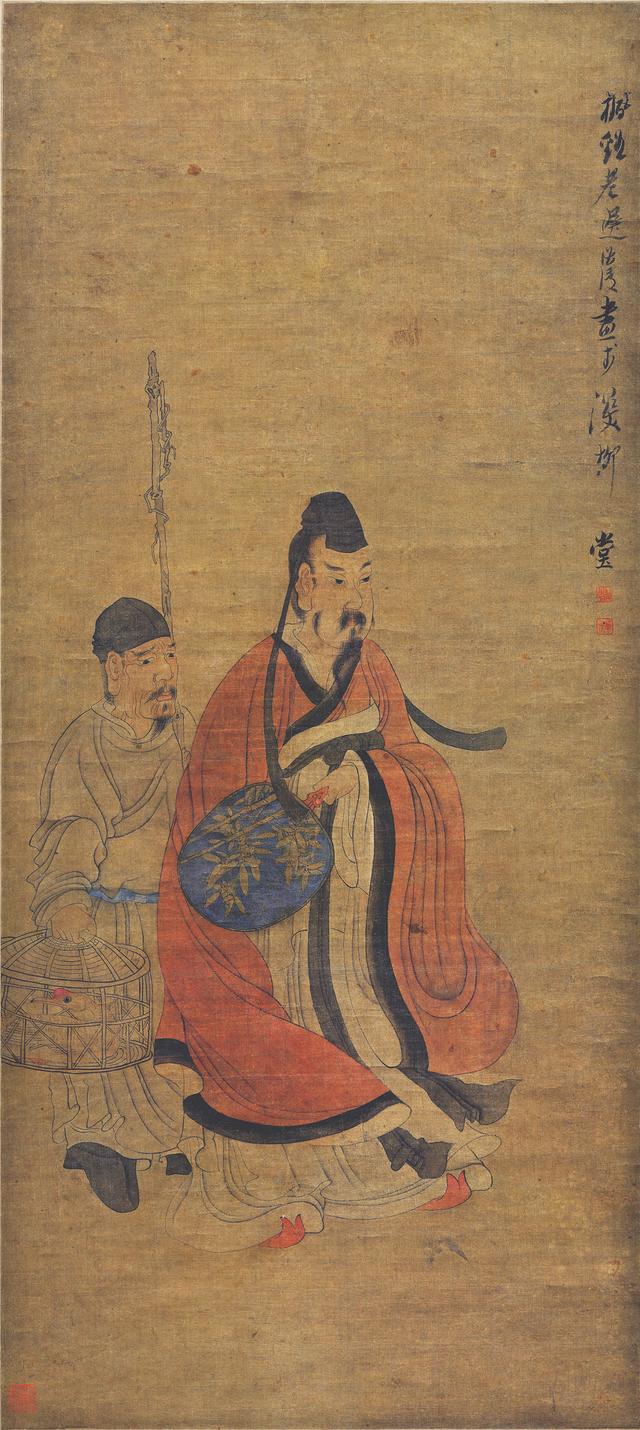
Ming Chen Hong's caged goose picture in the collection of Zhejiang Provincial Museum
There is another type of figure painting made by Chen Hongshou in his later years, that is, the grotesque type. There are also two types of weird shapes, one is a common one with a big head and a short body; the other is only weird but not weird.
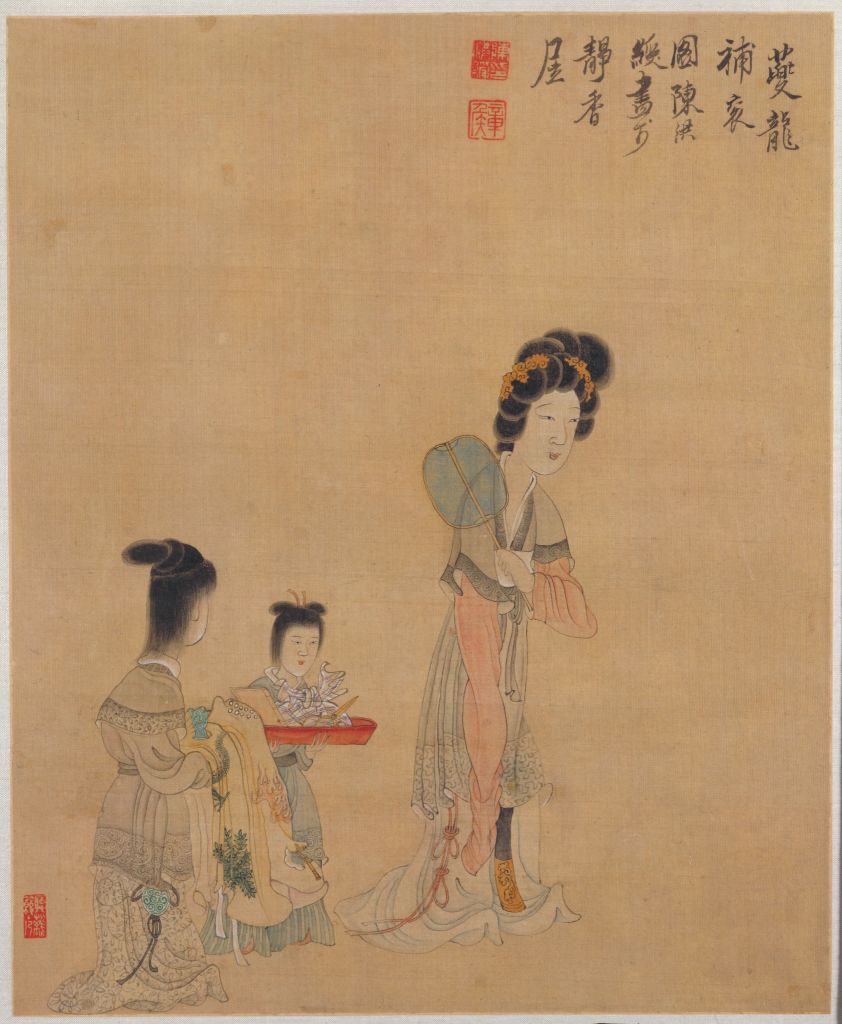
Ming Chen Hongshou Miscellaneous Paintings Collection of Kuilong Complementary Gon Collection of the Palace Museum
Although his figure paintings have certain distortions, the proportions are basically the same. However, in the former figure paintings with large heads and short statures, he deliberately exaggerated the proportions and made them strange. In a set of large albums of Chen Hongshou in the Palace Museum, there is a picture of "Kuilong Bugun Tu", which depicts three girls in total. half head length. Her head and body do not seem to belong to a person. The two girls in the back are also short and out of proportion. In addition, the lines are thin and round, the colors are pale and the style is elegant, all of which are the same as other works.
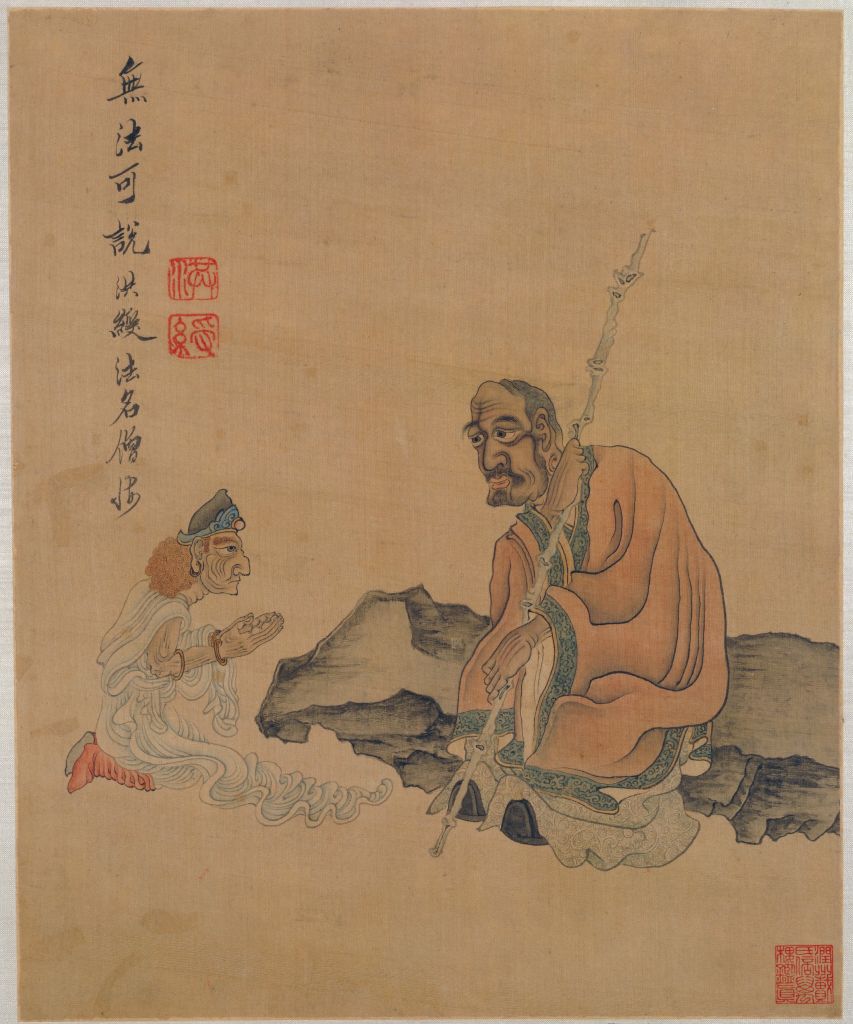
Ming Chen Hongshou's Miscellaneous Paintings The Unspeakable Collection of the Palace Museum
In the same album, there is also "Unspeakable". In the painting, there is an old Buddha sitting on a stone with a cane. Although it is a sitting statue, it can be seen that the head is big and the body is small. The old Buddha is kneeling in front of the Buddha listening to the Dharma. Also very weird. This picture may have been influenced by Guanxiu's paintings of Buddha and Arhat statues in the Five Dynasties period.
Chen Hongshou painted the most pictures of Tao Yuanming in his life, and before his death (at the age of 53), the long scroll "The Return of Tao Yuanming" is the most meaningful.
This set of paintings embodies many characteristics of Chen Hongshou's paintings in his later years. One is that the head is big and the body is short, but it is not exactly the same as the big head and small body of the characters in "Kuilong Bugun Tu". One person's head resting on another person's body looks awkward. In this set of pictures, although the figures are large in heads and short in bodies, they are relatively fit, and belong to the category of "Chen Hongshou painted figures with large trunks (burly and sturdy)" as Zhang Geng said. The second is that the lines are similar to other paintings in the later years, but they are more sparse, more scattered (the effect of casualness is called scattered), and more sophisticated, and the colors are paler than those of the early later years.
Chen Hongshou's figure painting matured earlier than his landscape, flower and bird paintings. In his prime, his figure painting had changed from "god" to "transformation", and in his later years, it became more "transformed". Entering the "chemical" to the end, it has reached its peak, it is perfect, and it can no longer be surpassed.
2. The influence of Chen Hongshou's paintings on Japanese Ukiyo-e
When Chen Hongshou's painting art matured and had a huge influence, it was also the day when the Japanese ukiyo-e rose and prospered. Japanese ukiyo-e painters claimed to have studied Chinese Tang Dynasty paintings and had ukiyo-e paintings. In fact, Japanese people rarely saw Tang Dynasty paintings at that time, and their painting methods were entirely from Chen Hongshou, which can be seen at a glance from the comparison of paintings.
Mao Qiling's "Farewell Biography of Chen Laolian":
North Korea, Wuliangha, Japan, Samarkand, Wusi possession of lotus paintings, it is very valuable. Thousands of domestic models are passed on. Yuan Kun in Yongdong, poor as a bookkeeper for the Western Confucian Classics, who was about to return from the two cut bamboos in the Tibetan lotus painting, was a great joy to the Japanese lord. Also pass the mold pen also.
North Korea, Mongolia, Japan and other countries have purchased Chen Laolian's paintings, which are of high value. There are thousands of people living by imitating Chen Hongshou's paintings (counterfeiting). Someone used a bamboo pole to hide two paintings by Chen Hongshou and presented them to the Japanese Lord (the Emperor of Japan). However, these two paintings by Chen Hongshou are also imitations, not the original works of Chen Hongshou.
It can be seen that the whole country in Japan admires Chen Hongshou's art.
In fact, Chen Hongshou's paintings are also from the Tang Dynasty, and the Japanese Ukiyo-e is called to learn from the Tang Dynasty, but in fact it is to learn from Chen Hongshou, and there are some similarities.
Ukiyo-e had a huge impact in Europe in the nineteenth and twentieth centuries. The success of world-class painters such as Van Gogh, Matisse, Monet, and Cezanne, as well as German expressionist paintings, were all influenced by Ukiyo-e and Chinese paintings. In fact, he also learned from Chen Hongshou indirectly and succeeded. Here we can see the great influence of Chen Hongshou.
Chavatskaya, director of the Soviet Union and later the Russian State Institute of Oriental Studies, said many times: "Chen Hongshou is the number one painter in China". The author once persuaded her to change it to: "Chen Hongshou was the number one painter in the Ming Dynasty," she said decisively: "No, Chen Hongshou is the number one painter in China. He is also the number one painter in the world."
3. The influence of Chen Hongshou's art on later generations
Chen Hongshou is a painter of figures, flowers, birds, and landscapes. He has a role in the history of Chinese painting art. "Inheriting the past" is not conventional, but embarks on a new path of his own in the time-honored traditional Chinese painting, and has achieved unprecedented artistic results; "inheriting the future" means that his artistic ideas and painting style not only affect the Generations, but also had a huge impact on later generations. The admiration and high evaluation of his predecessors, peers, and juniors can be seen.
It was mentioned in the literature that "Nan Chen Bei Cui" represented the highest achievement of figure painting at that time. "Nanchen" means Chen Hongshou, "Northern Cui" means Cui Zizhong (1574~1644), alphabetical name, name Qingwei, from Laiyang, Shandong. Cui Zizhong is located in the north, and his general style of figure painting is very consistent with Chen Laolian, that is, it has the same grotesque and decorative beauty. However, Cui Zizhong has more ideas of loyalty to the monarch and less ideas of democracy, so there is a big difference between Chen and Cui in the choice of subject matter. Reflected in the specific picture, Cui is more bookish than Chen Laolian, and is more restrained in deformation and more decorative. In terms of overall achievements and influence, Cui Zizhong is far inferior to Chen Laolian, and far less impactful than Chen Laolian. The reason why "South Chen Bei Cui" is equally famous is because Cui Zizhong is about 25 years older than Chen Hongshou, older than Chen Hongshou's teacher. Cui Zizhong became famous earlier, and he lives in Beijing, close to the water tower, easy to know, and is also a student of Dong Qichang. Dong Qichang was the emperor's teacher and held an important position. He was a master of both landscape painting and painting theory. Most of the important figures in the painting world at that time were his students. All the painters who voted under Dong Qichang's family are also easy to become famous. Cui Zizhong has the above factors, so he is famous. Of course, Cui Zizhong's paintings are still good. Except for Chen Hongshou, no one can compare with him. Chen Hongshou was not under Dong Qichang's family, and he disapproved of this generation of masters. In his painting theory, he seriously criticized Dong Qichang and Chen Jiru. His fame and influence come entirely from his painting achievements, and "South Chen Bei Cui" cannot actually be juxtaposed. The influence of "Beicui" on later generations is indeed far less than that of "Southern Chen".
Chen Hongshou's school of painting was very large at that time. Mao Qiling said: "There are thousands of people who pass on models to live." There were so many people in need of his paintings at that time that even though the bamboo painting by Chen Hongshou at the age of 22 was very sloppy, some later famous figures were willing to exchange white horses with collectors. Volume 2 of the Continued Compilation of Picture Treasures also records:
Chen Hongshou...is talented, knowledgeable and good drinker, bold and uninhibited, and has the taste of Jin people. Able to calligraphy and painting, the figures of flowers and birds are all exquisite, and they have become a family in middle age. Poems were established after being drunk, calligraphy and painting became very popular, and they became famous for a while. There were many scholars. So far, they have obtained their manuscripts, and they have been mixed in the world.
Chen Hongshou's paintings had an even greater impact on later generations. Figure paintings in the early and late Qing Dynasty, following the old lotus painting method, were once all the rage. During the Shunzhi and Kangxi years of the Qing Dynasty, Chen Hongshou's concubine Hu Jingran, son Chen Xiaolian, daughter Chen Daoyun, and students Yan Zhan, Lu Xin, Wei Xiang, Ding Shu, Wang Wei, Sima Wei, Shen Wuji, Zhu Tianqi, etc., can all inherit his paintings. The style has a certain reputation in the art world. The subsequent Yongzheng and Qianlong reigns, Wang Shugu and Luo Feng, were able to melt the old lotus painting method and create a new look.
Chen Hongshou's concubine Hu Jingran, her paintings of flowers, birds, plants and insects are wonderful. At that time, many literati recorded her paintings, and they were full of admiration. Wang Shizhen, a literary leader in the Qing Dynasty, in his book "Chibei Outan", devoted a section to "Lady Paintings", remembering Hu Jingchang (original note: Chen Hongshou's concubine), "Weeds, insects, flowers and birds are all wonderful products".

Chen Xiaolian Narcissus Birthday (Part) Collection of Shaoxing Museum
Among Chen Hongshou's children, those who are famous for their paintings include their eldest daughter Chen Daoyun and fourth son Chen Xiaolian. Chen Xiaolian's landscapes, figures, flowers and birds, and calligraphy all closely resemble her father's. At that time, people regarded Xiaolian's paintings as old lotus. There are still many paintings of Xiao Lian in the world. The Zhejiang Provincial Museum has Xiao Lian's "Snow Scene Figures" and the scroll scroll. Chen Hongshou's paintings use ancient methods, and ancient paintings are mostly painted on silk, so Xiaolian's paintings are also painted on silk. And Xiaolian's picture on paper does not seem to be a fine work, but it is Xiaolian's early work. The Tianjin Art Museum has Xiaolian's "Three Religions", which depicts Laozi (the ancestor of Taoism), Confucius (the ancestor of Confucianism), and Sakyamuni (the ancestor of Buddhism) standing together, so it is called "Three Religions". . Looking at the shape of its characters, it is entirely from Lao Lian, but it is not quaint enough. The lines of the clothes and lines follow Lao Lian's strong-year-old brushwork, and they are carefully rectified, but they are not clear and round. Of course, although Xiao Lian's painting is mastered by his father, he still has a certain personal spiritual outlook. This picture should be the work of Xiao Lian when he was middle-aged. The "Arhat" painted by Chen Xiaolian in the "Chen Laolian·Chen Characters and Father and Son Collection" collected by Weng Wange in the United States is a late work of his father. inferior to his father. Among them, "Shanshui Tu" is also an early work of Xue Laolian in his later years, and they are all very similar. When it is Xiaolian's mature work.
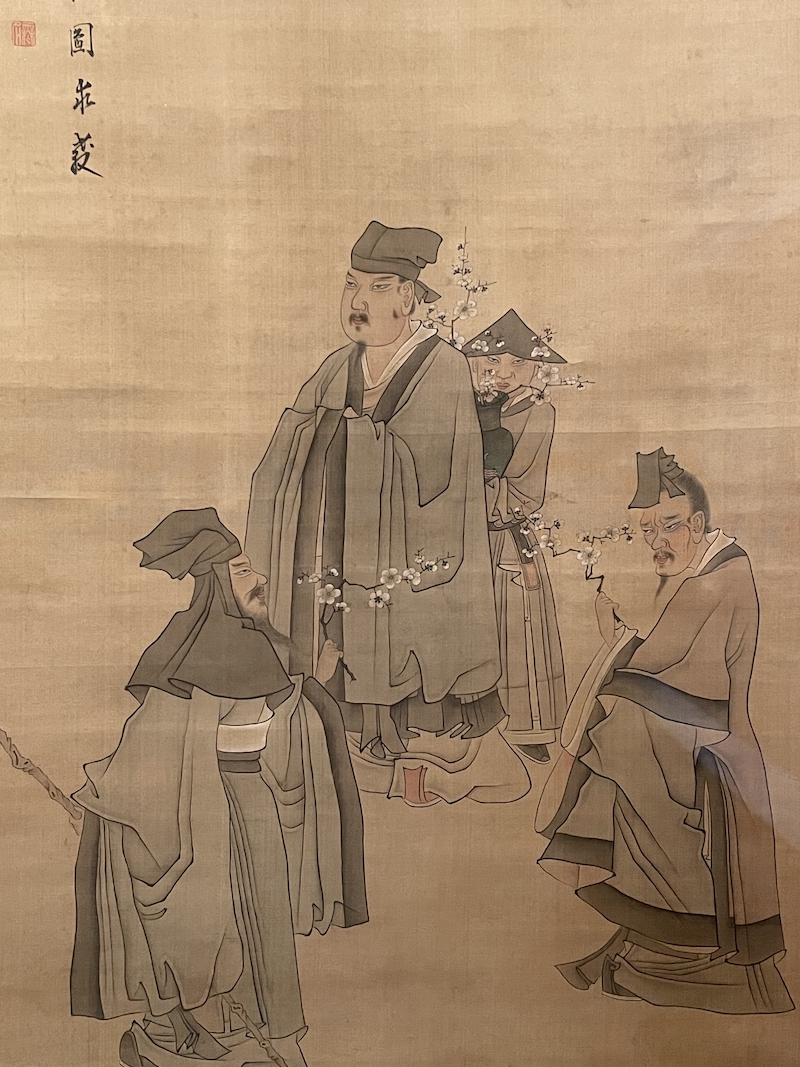
Chen Xiaolian Dou Mei Tu (part) Collection of Tsinghua University Art Museum
Xiao Lian's mature works are almost the same as her father's mature works, and can be called the second of Lao Lian. Therefore, Xiao Lian's paintings are recorded in various painting history documents. Xiaolian occupies a high position in the history of painting and is one of the important painters in the Chen Hongshou School of Painting.
Chen Hongshou's disciples have high achievements and are listed in the history of painting. The first person to enter the house was Lu Xin, courtesy name Shanzi, a native of Shanyin. Good figures of flowers and birds, the whole teacher Chen Hongshou, the painting is almost indistinguishable from the old lotus. Many of Chen Hongshou's fake paintings were created by him, and no one can tell them apart. Few of his paintings have been handed down to the world, because many of the paintings were sold in the name of Chen Hongshou after they were completed. The Zhejiang Museum has a scroll of his "Drunken Yin Tu" (this picture was published in "Yiyuan Diaoying" No. 18, p. 12, Shanghai People's Fine Arts Publishing House, October 1982 edition, ink and color on silk, 114×45.8 cm), painted a child and three adults who were singing while drunk. The figures, outlines, and inscriptions are all very similar to his teacher. However, when running the pen, it stopped a little, and it lacked the kung fu of Lao Lian to make a few strokes without stopping. But it also seems more fluid and casual, not funny. It is said that in Chen Hongshou's paintings in his later years, the useful brushes paused slightly and seemed to flow casually, which may all be the works of Lu Shanzi. Chen Hongshou's lines are particularly quiet and stable.
Chen Hongshou's most proud disciple, Yan Zhan, whose courtesy name is Shuizi, is a kind-hearted figure of flowers and birds. Chen Hongshou's proud works are often called Yan Shuizi Coloring. Lao Lian once inscribed Shuizi's "Spring and Autumn Picture", saying: "Hongshou is old, the characters are one, and Shuizi is attentive." The Zhejiang Provincial Museum has Yan Zhan's "Sound Appreciation Picture" scroll. Under the big pine tree, a girl is playing the piano, and a man and a beautiful woman are admiring it. The brushes and colors are all like his master, but the background part of the trees and stones are slightly inferior. Yan Zhan was quite famous at that time, and he was mentioned in many literati's poetry collections, which can be said to be famous in the history of painting.
There are many other disciples of Chen Hongshou, but only in the book "Visit and Hearing in Yuehua Painting": Sima Ziyu, Lu Zengxi, Luo Kun, Ding Shu, Lai Luqian (Chen Hongshou's wife and brother), Shen Wuji, Zhu Tianqi, Shang Yushuo Wait. "Yuehuajianwen" records that the painter is limited to Yuezhong, and there are many omissions. There are many other painters who have a certain position in the history of painting, and they are not limited to Yuezhong. I will not go into details.

Luo Pin's "The Scroll of Jinnong" Shaoxing Museum
Looking at the history of painting behind Chen Hongshou, there are many painters who have learned from him and achieved a certain reputation in the painting circle. Luo Pin, one of the "Eight Eccentrics of Yangzhou" in the mid-Qing Dynasty, taught a wide range of schools in his early years and specialized in Chen Hongshou in his later years, so his paintings are very similar to Laolian. I once saw Luo Pin's "Portrait of Meng Haoran" in Jingyuanzhai, University of California, USA. From a distance, I would mistake it for Chen Hongshou's work. Luo Pin became the most important painter in the later period of "Eight Eccentrics of Yangzhou" because of his above-average painting style, which made him famous all over the country.
In the mid-Qing Dynasty, Yangzhou was the center of the painting world. In the late Qing Dynasty, Shanghai became an important center of painting circles. Chen Hongshou can be said to be the ancestor of Shanghai-style figure painting. Ren Xiong, Ren Xun, and Ren Yi are known as the "Three Rens of the Sea", and sometimes Ren Xiong's son, Ren Yu, is known as the "Four Rens", which are the most famous.
Ren Xiong (1820~1857), a native of Xiaoshan, Zhejiang Province, with the courtesy name Weichang and his nickname of Xiangpu. He often travels to and from Shanghai, Suzhou and other places to sell paintings. His paintings were started by Chen Hongshou and copied for a long time, so that he can obtain the essence of Laolian paintings. The Nanjing Museum has Ren Xiong's copy of Chen Hongshou's "Ladies Picture" scroll, depicting a lady holding a fan, no background, self-inscription on the upper left: "Xiannian Yimao (1855) on the third day of Qingming, Wei Changxiong copied Zhang Houben in Yubi Mountain habitat." It can be seen that Ren Xiong was still copying Chen Hongshou's paintings two years before his death. Generally speaking, his paintings resemble those of Chen Hongshou in his prime. Ren Xiong learned from Chen Hongshou's paintings, and added more color and richness, thus forming a personal appearance. But his personal appearance was obviously developed on the basis of Chen Hongshou. Ren Xiong learned from Chen Hongshou everywhere, and his characters are long in flowers, birds and landscapes, and he even painted woodcut figures, such as "Lie Xianjiu", "Gao Shi Zhuan", "Yu Yue Xian Xian Biography", "The Legend of the Swordsman" and "The Legend of the Swordsman". Some books are engraved in a moment. In the Bingxu year of Guangxu (1886), the Shanghai Tong Wenshu Bureau had photocopied "The Four Biography of Mr. Ren Weichang's Paintings". In 1985, Beijing China Bookstore made another photocopy according to the Guangxu edition. In 1987, Jiangsu Fine Arts Publishing House published a set of Lie Xianjiu Brand. It can be seen that Ren Xiong's woodcuts are all from Chen Hongshou's prints, and the lines are very deep. His personal style, like his scroll paintings, is based on Chen Hongshou's changes and additions. Ren Xiong is not only the most influential painter in the "Four Rens", but also one of the most influential painters in the Shanghai School of Painting, and the "Three Rens" are all his schools.

Ren Xun Confucius Scroll Collection of Xiaoshan Museum
Ren Xun (1836~1893), the younger brother of Ren Xiong, with the courtesy name Fuchang, was influenced by Ren Xiong in his paintings, and also learned from Chen Hongshou, whose level is no less than that of Chen Hongshou. It's just that the impact is not as great as Ren Xiong's.
When he arrived at Ren Yi, the Shanghai faction flourished. Ren Yi (1840~1896), whose ancestral home is Shanyin, Zhejiang, was born in Xiaoshan. He is Ren Xiong's student. Ren Yi also learned from Chen Hongshou in his paintings, but he made a living by selling paintings and painted very fast. Therefore, he liked to use nail-head and mouse-tailed lines and learned too much from Chen Hongshou's middle-aged painting method. But Ren Yi's serious paintings are quite skillful, and they are closer to Chen Hongshou. Ren Yi's flower and bird figures all follow Chen Hongshou, but he also participates in other schools, and attaches great importance to sketching, forming a fresh, bright and lively personal style. After succeeding Xiong, he became the most famous and representative painter of the Shanghai School. Ren Yi has had a great influence on the paintings of later generations (until now).
Xie Zhiliu, a famous contemporary Shanghai painter, also studied under Chen Hongshou since childhood. At that time, he was an "old lotus fan". In the extant paintings of his early and middle age, traces of Chen Hongshou's master can be seen. Xie Zhiliu's name also happens to be opposite to Lao Lian (Child Liu Yi Lao Lian). In addition, he is one of the earliest contemporary scholars to study Chen Hongshou.
Chen Hongshou's paintings not only nurtured countless upper-class painters, but also subsidized countless folk painters. Zhang Shan said in the early Qing Dynasty: "Chen Zhanghou's "Water Margin", in recent years, the picturesque lamps, such as the small screen on the seat, are all taken as manuscripts."
For more than 300 years, Chen Hongshou's paintings have been radiating strange brilliance in the Chinese painting circle. In particular, his paintings laid the foundation of the Shanghai School, the largest painting school in modern Chinese painting circles. The influence of the Shanghai faction has spread all over the country. Even as far as the United States, Japan, Britain, Canada, France and other countries and Southeast Asia.
Chen Hongshou's paintings are collected in many major museums in China and have become one of China's national treasures. Moreover, some large museums in Europe, the United States, Japan and other countries as well as many countries in Southeast Asia also have collections and become their treasures. Professor Jing Suzuki of Japan has included 41 sets of works by Chen Hongshou collected in Europe, the United States, Japan and other countries in the "General Catalogue of Chinese Paintings" (including scrolls, volumes, and 12 volumes printed as one set), but this statistic is very inaccurate. completely. Some of the Chen Hongshou paintings I saw in the United States, and many others have not yet been counted. As for the paintings of the painters of the Chen Hongshou School, there are more.
Chen Hongshou is not only one of the greatest painters in China, but also has a high status in the world art circle. With the in-depth research of scholars from all over the world and the improvement of people's aesthetic ability, Chen Hongshou's artistic status will be higher and higher, which is undoubtedly.
August 2022 at Renmin University of China
(This article was provided by Shaoxing Museum, originally titled "The Art and Influence of Chen Hongshou", edited by The Paper when it was published.)


